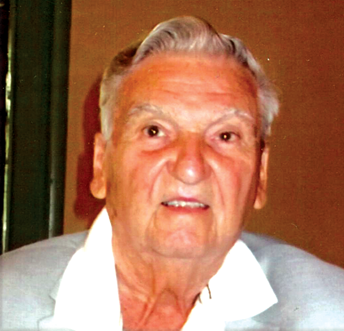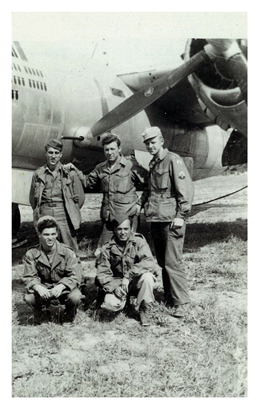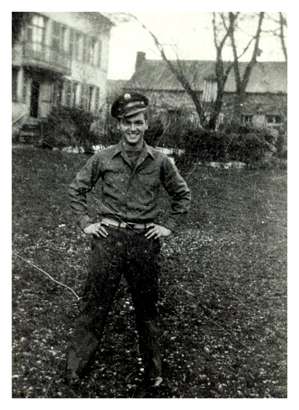
By: Helen Mooradkanian – October, 2013
TEWKSBURY – Nineteen-year old George A. Flibotte, U.S. Army Air Corps, now of Tewksbury, was with the Ninth Air Force stationed across the English Channel from Omaha Beach on D-Day, June 6, 1944. As part of the 1925th Ordnance Ammunition Company, he was loading bombs onto convoys of trucks to supply the B-25s and B-26s. These medium bombers provided support to the amphibious landings and ground troops during the invasion of Normandy, while the Eighth Air Force heavy bombers, B-17s and B-24s, flew bombing raids into Germany.
Early on the morning of June 6, the skies filled with thousands of paratroopers dropping behind enemy lines. A massive naval armada continuously bombarded the beaches. Loaded “Higgins boats”—LCVP or landing crafts, vehicle and personnel—carried thousands of troops who would hit Omaha Beach in multiple assault waves. The Ninth Air Force medium bombers—B-25s, B-26s, and Douglas A-26 Invaders—flying as low as 12,000 to 15,000 feet—strafed the enemy gun emplacements and coastal areas. Fighter planes swept beyond the beaches to flush out enemy planes.
“How our men scaled those cliffs at Omaha Beach, I’ll never know, with the Germans hidden on the cliff tops, waiting for them, ready with machine guns and mortar,” George recalled. “On the second day after the invasion, the medics ran out of plasma and sent out an urgent call for blood donors. At the time, we were in the mess hall. We immediately volunteered, gave blood, put away our mess kits, and rushed back to the bomb dump, where we loaded bombs onto truck convoys for delivery to planes.”
The air cover was massive. The U.S. Army Air Force reported it alone had “dispatched more than 8,000 planes on missions directly related to the invasion.”
George had entered the Army Air Corps in June 1943, at the age of 18, from North Reading. While training as a radio technician at Scott Field, Illinois, his plans were changed abruptly. Two weeks shy of completing his course, he was ordered to leave for England at once. “On May 13, 1944, we boarded the SS Brazil, a converted ocean liner, and arrived at Liverpool, England on May 24, assigned to the Ninth’s 1925th Ordnance Ammo. Less than two weeks later, the D-Day invasion began.”
Constantly on the ready as the Allies raced to Berlin, and the bombing attacks intensified, there was no opportunity for a furlough until George was discharged in 1946.

The Normandy invasion opened up a new type of warfare for the Ninth Air Force. “We were constantly moving, moving, moving from one site to another throughout Europe.”
While the Eighth Air Force with its heavy bombers flew from semi-permanent installations directly into the heart of Germany, the Ninth’s medium bombers followed the advancing troops as they moved swiftly across France, Belgium, and Germany, following General George Patton’s Third Army.
As the 1925th Ordnance Ammunition Company moved, George spent a couple of months at various sites in England from May through July 1944 while the Ninth sent out bombers and fighter-bombers during the Normandy Campaign, including the Battle of the Bulge.
By the end of September 1944, the Ninth Air Force had moved bases from England to the continent. “We flew in a C-47 from England to Nazi-occupied northern France: Fall 1944 (Senlis), December 1944 (Le Nouvion), January and February 1945 (Bohain and Vaux, north of Paris), April 1945 (Sillery, near Reims, 80 miles northeast of Paris), May 1945 (Saint Dizier and Liesse), June 1945 (Bucy). In 1945 he was in Belgium and then in Germany.
Bombs delivered on-time!
With the Ninth moving quickly across Europe, bombs were stockpiled outdoors, off-site from an air base—in case the airfield were hit—yet centrally located so as to be within a few mile radius of several airfields, accessible either by truck convoys or railcars.
“We had a dozen crews in my company, with four to six men in each. We received, stacked, stored, and shipped. Get ’em in—get ’em out! That was our slogan.”
After the bombs came in by ship from the States, they were distributed by rail to various points. “Each day we went down to the rail yards to receive incoming shipments, using fork lift trucks, mobile cranes, and crawler tractors to unload bombs from railcars onto trucks, which then hauled them to the bomb dump. There we uncrated the bombs and stacked them by type and size: fragmentation cluster bombs (20- or 25-lb in a “bird cage”). These bombs were effective against ground troops, spraying a 120-foot area. We also stored 100-lb bombs, 250-lb bombs, 500-lb bombs, as well as l,000- and 2,000-lb bombs. Our bombers attacked railroad equipment, ammo dumps, planes on the ground, rail terminals, marshaling yards, railroad bridges, concrete docks, and piers, as well as massive suspension bridges.
With the Ninth’s bombing missions accelerating in Europe, the 1925th Ordnance Ammo Company played a crucial role in on-time delivery.

As the German Army was being pushed back, George’s ordnance company often slept in abandoned chateaux in France and Belgium for a month or so at a time as they moved from site to site. In December 1944 they moved into a vacant chateau outside the town of Le Nouvion in northern France, once under Nazi occupation.
“It was a cold winter but we brought in a generator, hooked up some electrical wiring, made the necessary changes, and ended up with heat and electricity. The following April of 1945, we stayed for a month in another abandoned chateau not far from Reims, outside the town of Sillery, ‘the champagne capital of the world’ at that time, while we closed down two bomb dumps and shipped the bombs to Germany. Outside Frankfurt, Germany, we took over a partially bombed-out airbase and fixed it up to make some pretty decent living quarters.”
Far removed from the abandoned chateaux George used as temporary living quarters was his three-day ride between France and Belgium in the infamous “40 and 8” boxcars. The “40 and 8” originated in France during World War I. Half the size of U.S. railcars, these boxcars measured only 20.5 feet long and 8.5 feet wide. During WWII, they transported troops to and from the front lines in Europe and North Africa. The Nazis used them to transport POWs.
Stories are told of how soldiers, in these unheated boxcars, nearly froze to death in the winter despite attempts to light fires. In the summer, the heat was unbearable. In many cases, they were known to start-and-stop, start-and-stop every 50 yards or so. Fortunately, for George, the three-day journey took place in the springtime. “Although the interior was primitive,” he said, “at least the boxcars kept moving. Our mattress was a bale of hay spread out on the floor. Our pillow, the duffle bag we carried.”
George Flibotte answered the call. He played a crucial role in supporting the Ninth Air Force in the liberation of Europe. Although distance separated him from his earthly father, his heavenly Father was watching over him wherever he went. As Jesus said in His parable of the talents, “Well done, good and faithful servant! You have been faithful with a few things, I will put you in charge of many things” (Matthew 25:14ff).
 Helen Mooradkanian is our Valley Patriot Hero columnist and a former business writer. She is also a member of the Merrimack Valley Tea Party, You can email Helen at hsmoor@verizon.net
Helen Mooradkanian is our Valley Patriot Hero columnist and a former business writer. She is also a member of the Merrimack Valley Tea Party, You can email Helen at hsmoor@verizon.net
